Spiny balls of vanadium oxide could become useful molecular scaffolding.
Tweaking a standard chemical method to make nanotubes has provided researchers with a structure that looks just like a miniature sea urchin. The nano-urchin’s spines could prove useful as scaffolding for further molecular construction, the scientists say.
The urchin is made from vanadium oxide nanotubes, packed together with a much higher density than previous structures made from the same materials. ’They’re not only really dense, but really uniform,’ said Colm O’Dwyer of the Tyndall National Institute, University College Cork, Ireland, and part of the research team.

Changing the high pressure and high humidity conditions used in such nanotube syntheses can produce a variety of different structures. But the nano-urchins were still a surprising result, considering the team used only slightly different procedures, said O’Dwyer.
On closer inspection, they noticed that each nanotube in the urchin was almost identical to those seen during single nanotube synthesis, where flat sheets of vanadium oxide roll up into cylinders.
The team has shown that the nano-urchin forms when these sheets merge before they begin to roll up. ’That’s the only real difference between stand-alone nanotube synthesis and the nano-urchin,’ said O’Dwyer. He adds that these are the most uniform vanadium oxide tubes formed to date in terms of wall thickness, the number of layers, and the dimensions of the hollow centre.
The unprecedented density of the urchin’s nanotubes provides a wealth of possible applications, said O’Dwyer. The high surface area could be used to support catalysis, for example. But the researchers are particularly interested in using the structures as supports for other materials.
Hoping that a battery based on nano-urchins could store the same amount of charge as a standard battery in a much smaller volume, the scientists have packed lithium atoms into the spaces between the tubes’ atoms. ’Inserting the lithium into the urchin is not that difficult at all,’ said O’Dwyer, ’The only difficult part, which we haven’t begun to do yet, is to sediment these on a polymer base, as for lithium polymer batteries.’
The team also hope to insert optically-active nanoparticles, known as quantum dots, which could prove useful in optoelectronic devices.
Bea Perks
If you want to develop high performance materials with nanometre-scale designs and environmentally friendly production processes, you should look to nature for inspiration.
Nanotechnologists employ algal architects
Natural diatom skeletons form a scaffold for artificial nano constructs
References
C O'Dwyer et al, Chem. Mater., 2006, 18, 3016






No comments yet